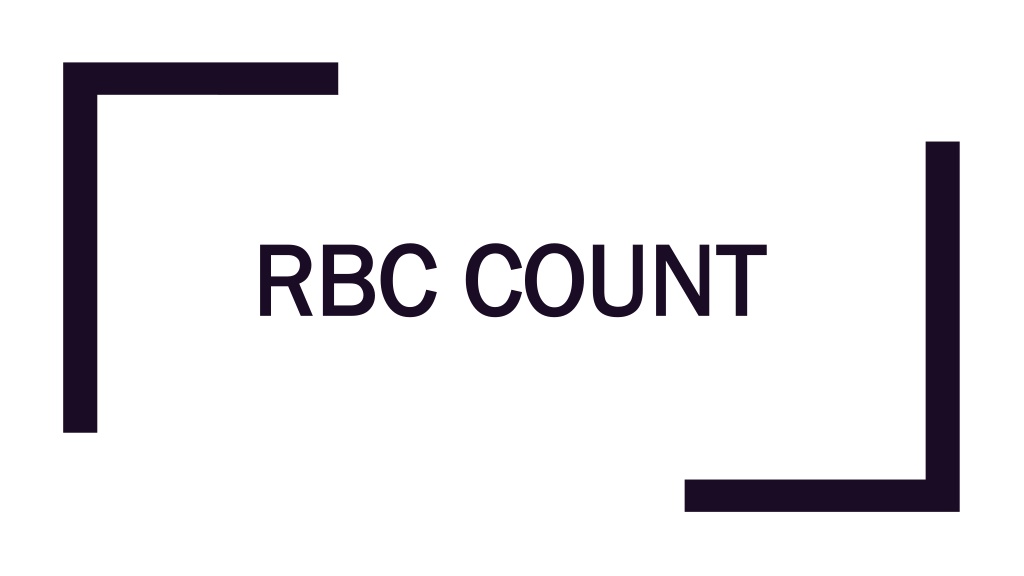Understanding Red Blood Cell Count Methods
Explore the principles, normal ranges, and conditions related to red blood cell count. Learn about the apparatus and materials needed for RBC counting, as well as the procedure involved. Understand how changes in RBC count can indicate various health conditions like polycythemia and anemia.
Uploaded on Aug 05, 2024 | 0 Views
Download Presentation

Please find below an Image/Link to download the presentation.
The content on the website is provided AS IS for your information and personal use only. It may not be sold, licensed, or shared on other websites without obtaining consent from the author. Download presentation by click this link. If you encounter any issues during the download, it is possible that the publisher has removed the file from their server.
E N D
Presentation Transcript
RBC COUNT RBC COUNT
Principle The blood is diluted 200 times in a red cell pipette and the cells are counted in the counting chamber. Knowing the dilution employed, the red cells number in undiluted blood can easily be calculated.
Normal red cell count The average red cell counts and their ranges are: Males = (4.75 6.0) million/mm3, (5.0 million/mm3) Females = (4.0 5.5) million/mm3, (4.5 million/mm3)
Normal red cell count Increased RBC count (polycythemia) is seen in; 1. Polycythemia vera (primary polycythemia) 2. Secondary polycythemia 3. Polycythemia due to hemoconcentration 4. Physiological polycythemia
Normal red cell count Decreased RBC count (anemia) is seen in; 1. Medications 2. Genetic conditions 3. Bleeding 4. Medical conditions 5. Nutritional deficiencies 6. Physiological conditions
Apparatus & materials 1. Microscope 2. RBC pipette 3. Improved Neubauer chamber with coverslip 4. Disposable blood lancet, sterile cotton, & 70% alcohol
Apparatus & materials 5. Hayem s fluid (RBC diluting fluid); Thpe ideal fluid should be isotonic. It should preserve the shape of RBCs and also prevent their autolysis so that they could be counted even several hours after diluting the blood if necessary. It should prevent agglutination and not get spoiled on keeping.
Apparatus & materials Composition of Hayem s fluid; 1. Sodium chloride (NaCl) (0.50 g) 2. Sodium sulfate (??????) (2.50 g) 3. Mercuric chloride (?????) (0.25 g) 4. Distilled water (100 ml)
Procedure 1. Place about 2 ml of Hayem s fluid in a watch glass. 2. Examine the chamber, with the coverslip centred on it, under low magnification. Adjust the illumination and focus the central RBC square on the counting grid containing 25 groups of 16 smallest squares each.
Procedure 3. Filling the pipette with blood and diluting it; Get a finger-prick. Wipe the first 2 drops of blood and fill the pipette up to the mark 0.5. Suck Hayem s fluid to the mark 101 and mix the contents of the bulb for 3 4 minutes.
Procedure 4. Charge the chamber with diluted blood. 5. Move the chamber to the microscope and focus the grid to see the central square with the red cells distributed all over. Wait for 3 4 minutes for the cells to settle down because they cannot be counted when they are moving.
Procedure 6. Counting the cells Switch over to high magnification and check the distribution of cells. 7. Move the chamber carefully and bring the left upper corner block of 16 smallest squares in the field of view.
Procedure 8. Move the chamber carefully till you reach the right upper corner block of 16 smallest squares and count the cells as before. Then move on to the right lower corner and then left lower corner groups, and finally count the cells in the central block of 16 smallest squares.
The counting grid The large central square (RBC square) is divided into 25 medium squares each with triple lines. Each of these 25 squares are divided into 16 small squares each with single lines.
1 mm Length of the medium square= 1/5 mm RBC RBC Width of the medium square= 1/5 mm Depth of the square= 1/10 mm 1 mm RBC Area of the medium square=1/5 * 1/5= 1/25 mm2 Volume of the medium square= 1/25 * 1/10= 1/250 mm3 RBC RBC Volume of 5 medium squares= 1/250 * 5= 1/50 mm3
0.2 mm Length of the small square= 1/5*1/4= 1/20 mm Width of the small square= 1/5*1/4= 1/20 mm Depth of the square= 1/10 mm 0.2 mm RBC Area of small square=1/20 * 1/20= 1/400 mm2 Volume of small square= 1/400 * 1/10= 1/4000 mm3 Volume of 80 small squares= 1/4000 * 80= 1/50 mm3
Rules for counting Cells lying within a square are to be counted with that square. Cells lying on or touching its lower horizontal and left vertical lines are to be counted with that particular square (L shape rule).
Rules for counting Cells lying on or touching its upper horizontal and right vertical lines are to be omitted from that square because they will be counted with the adjacent squares.
Observations and results Add up the number of cells in each of the 5 blocks of 16 smallest squares. A difference of more than 20 between any 2 blocks indicates uneven distribution.
Observations and results Calculation of dilution factor The volume of the bulb is 100. This gives a dilution of 0.5 in 100, or 1 in 200. The dilution factor = 1/200.
Observations and results We can calculate the number of red cells as shown below: The volume of calculated area= 1/50 mm3 The dilution factor = 1/200 The diluted volume =1/50 * 1/200 = 1/10000 mm3
Observations and results If cell counted = N RBC count = N 1 1 10000 RBC count (million/mm3) = N * 10000
Observations and results Express your result as ..... million/mm3. The average cell counts and their ranges are: Males = (4.75 6.0) million/mm3, (5.0 million/mm3) Females = (4.0 5.5) million/mm3, (4.5 million/mm3)
PRECAUTIONS 1. Observe all precautions described for filling the pipette with blood and diluent, and charging the chamber. 2. Clean the chamber properly. Once cleaned, do not touch the central part. Any oils left from your fingers on the coverslip or the chamber are fatal to cell counting.
PRECAUTIONS 3. If there is over-charging or under-charging, wash, clean, dry, and refill the chamber. 4. Continuously rack the fine adjustment while counting the cells. 5. Do not draw diluents directly from the stock bottle as it may contaminate the solution with cells.

























